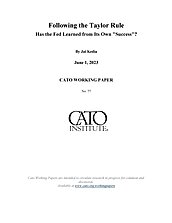The consensus among academics and Fed officials is that active monetary policy, following Paul Volcker’s chairmanship of the Federal Reserve and continuing into the tenures of Alan Greenspan and Ben Bernanke, was partly responsible for the Great Moderation: an economic period starting from the mid-1980s and lasting until the Great Recession. During this period, many developed economies were characterized by drastic declines in the volatility of aggregate macro indicators such as output, employment, and inflation.
Several papers have studied the effect of monetary policy on this increased macro stability. In a seminal publication, Clarida, Gali, and Gertler (2000) find that monetary policy was substantially more active (i.e., was more responsive to price changes) post-Volcker than pre-Volcker; consequently, monetary policy helped stabilize the economy in the post-Volcker period. Lubik and Schorfheide (2004) estimate a standard model of the U.S. economy for both periods and find that the post-Volcker period is better characterized with determinacy (i.e. the economy converging to a unique and stable equilibrium) while the pre-Volcker period is not. In a 2004 speech about the Great Moderation, ex-Fed Chair Ben Bernanke highlighted that “improvements in monetary policy, though certainly not the only factor, have probably been an important source of the Great Moderation,” additionally noting that “the period of highest volatility in both output and inflation, was also a period in which monetary policy performed quite poorly, relative to both earlier and later periods” (Bernanke, 2004).
Indeed, the evidence on this topic is mixed with the two papers discussed above supporting the role of the Fed while several others attribute the Great Moderation to other factors. For instance, Sims and Zha (2006) find empirical evidence of multiple monetary policy regimes, but ultimately conclude that “differences among regimes are not large enough to account for the rise, then decline, in inflation of the 1970s and 1980s.” Stock and Watson (2003) and Ahmed, et. al. (2004) show that the stability during the Great Moderation may simply be explained through good luck. That is, the volatility of aggregate macro measures was low simply because the volatility of their constituent shocks also happened to be low during the period. Even in his speech, Bernanke conceded that factors besides monetary policy may have also contributed, stating: “[t]hree types of explanations have been suggested for [the Great Moderation] … structural change, improved macroeconomic policies, and good luck.”
The present paper does not debate whether monetary policy was good or bad during the Volcker-Greenspan era or whether such “good” policy is necessary for macro stability. Instead, the paper assumes, as argued by Clarida, Gali, and Gertler (2000), that Fed policy during the Volcker-Greenspan era was good. The paper then examines whether the Fed continued this good policy in the period following the Great Moderation. To this end, this paper collects the estimated Taylor Rule coefficients of the Great Moderation period from Smets and Wouters (2007) and uses them to construct an implied series for the standard Fed policy tool – the federal funds rate (“FFR”). In other words, the paper constructs the policy rate that the Fed should have targeted, as suggested by the Taylor Rule during their “successful” era of monetary policy.

